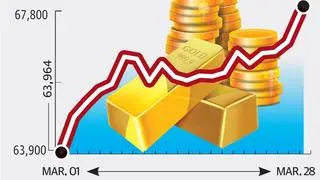The data on ETFs (exchange traded funds) from the World Gold Council (WGC) released last Thursday shows that investors’ expectation on a gold price recovery is waning. Recording a net outflow of 107.5 tonnes in March, ETFs across the globe have seen a net outflow for the second straight month. This also marked the fourth month of net outflow in the last five months. The outflow in March is the second highest since November 2016, when the outflow stood at 116.5 tonnes. November 2020 saw an outflow of 108.7 tonnes.
These trends indicate that gold prices remaining low in the last several months has pushed investors to look for alternatives. Unless there is a price recovery soon, this trend might continue to weigh on the yellow metal further. Regionally, only Asia has seen net inflows (7.2 tonnes) in March led by China (5.3 tonnes) and India (1.6 tonnes).
The WGC also released data on central bank demand for gold. While they sold nearly 29 tonnes in January, central bank activity remained muted on a net basis in February where the selling amounted to 3.3 tonnes. The largest monthly buying came from India (11.2 tonnes) and the largest selling from Turkey (11.7 tonnes). In the coming months, if the central banks on an aggregate basis become buyers, it can help the price firm up and boost sentiment.
Bullion prices were not much affected by incoming ETF data. They were appreciating for most of the week with a minor correction on Friday. But the drop was not very significant, and the market seems to have gotten over it and the resilience shown is certainly encouraging. The price could at least stop its descent if there isn't a rally.
Last week, the futures of gold (June expiry) on the Multi Commodity Exchange (MCX) gained 2.6 per cent as they closed at ₹46,593 (per 10 grams) and silver futures (May expiry) on the MCX posted a gain of 2.9 per cent as it ended at ₹66,983. In terms of dollar, gold and silver closed at $1,743.1 (per ounce) and at $25.24 (per ounce), thereby appreciating by 0.8 per cent and 1.1 per cent, respectively. The precious metals posted better returns in rupee terms last week as the Indian currency weakened by nearly 1.8 per cent against the dollar.
MCX-Gold (₹46,593)
Even as gold June futures witnessed a sluggish start last week, the contract gained momentum and gained steadily in subsequent sessions. It moved past resistance at ₹45,700 and the price is now above both 21- and 50-day moving averages (DMAs). While it closed the week at ₹46,593 after marking an intraweek high of ₹46,900, the price action over the past week is bullish and provides room for further increase in price.
This is supported by the daily relative strength index (RSI), which is now above the mid-point level of 50 for the first time since January. The moving average convergence divergence (MACD), which has started to trace positive trajectory a week ago, is now on the verge of entering positive territory. Moreover, good volumes are implying that the rally is not thin and the likelihood of it sustaining is high.
Given the above factors, futures will most likely climb above the nearest hurdle at ₹47,000 in the coming week. Hence, one can initiate new trades on declines and maintain stop-loss at ₹45,500. On a break of ₹47,000, the futures can be expected to rise to ₹48,300. Above that level, it can face resistance between ₹49,800 and ₹50,000. Notably, the 200-DMA coincides at ₹49,800 currently, making the resistance stronger. Supports from the current levels are at ₹46,000 and ₹45,500.
MCX-Silver (₹66,983)
Extending the recovery that happened in the second half of the week before, the May futures contract of silver went up throughout last week. The contract eased past the critical resistance of ₹65,000 and summed up the week at ₹66,983, thereby gaining 2.9 per cent.
Indicators such as RSI and MACD are showing signs of fresh momentum being built up. While the former has entered the bullish zone, the latter is showing that the trend is potentially turning bullish.
However, the rally is not substantiated by higher volume and moreover, the contract remains below the crucial resistance at ₹68,000. Also, unlike gold futures, silver futures could not rally past the prior high i.e., it was unable to form higher high. Since the contract has now gone back above ₹65,000, the chances of a decline from the current level is slim.
Hence, one can stay on the sidelines now and consider going long if the contract decisively breaches the resistance at ₹68,000. Once past ₹68,000, the futures can most probably rise to ₹71,850 with subsequent resistance at ₹75,000. Notable support below ₹65,000 can be spotted at ₹62,500.








